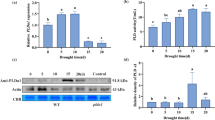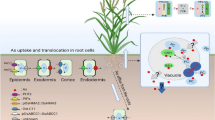Abstract
During the reduction of extracellular [Fe(CN)6]3− at the plasmalemma of intact, K+-starvedLemna gibba L. fronds, the external medium was acidified and K+ released, in the absence of inhibitors with rates of 10 e−/8.5 H+/1.5 K+ (μmol·(g FW)−1·−1). In K+ plants the larger K+ efflux caused a lag phase in extracellular acidification and a change in rates to 10 e−/6 H+/4 K+ and in the presence of CN−+salicylhydroxamic acid at pH 5 to 5.2 e−/0 H+/6.6 K+. The e− transfer was accompanied by a membrane depolarization of up to 100 mV and a cytosolic acidification of about 0.6 pH units, but only in K+ plants, where the extracellular acidification was smaller. These results indicate that a stimulation of the plasmalemma H+-ATPase may be triggered either by a cytosolic acidification or by a strong membrane depolarization. It is concluded that the redox system catalyses only uncoupled e− transfer without H+ transfer across the plasmalemma. The obligatory, but secondary charge compensation is partially achieved by the rapid K+ release upon membrane depolarization and partially by the activity of the plasma membrane H+-ATPase, but not by an e−/anion exchange. The extracellular acidification during [Fe(CN)6]3− reduction is generated by the conversion of a strong trivalent into a strong tetravalent anion. This acidification is caused by changes in the concentration ratio of strong cations to strong anions. Efflux of K+ and not the production of organic acids or NAD(P)H oxidation is the chemical cause of the measurable cytosolic acidification. Extracellular acidification was inversely correlated with intracellular acidification. Similarly, fusicoccin-induced pH changes were correlated with changes in the strong-ion concentration difference. Extracellular ± FC-dependent acidification and intracellular alkalinization of up to 0.6 pH units were strongly dependent on K+ fluxes. The ferricyanide-triggered trans-plasmalemma electron-transfer system is an example of how measurable pH changes are the consequence and not the cause of charge-transfer-induced changes in strong-ion fluxes.
Similar content being viewed by others
Abbreviations
- DCCD:
-
dicyclohexylcarbodiimide
- Em :
-
electrical membrane potential difference
- FC:
-
fusicoccin
- pHc :
-
cytosolic pH
- FW:
-
fresh weight
- PM:
-
plasmalemma
- SHAM:
-
salicylhydroxamic acid
- SID:
-
strong-ion concentration difference
References
Bertl, A., Felle, H. (1985) Cytoplasmic pH of root hair cells ofSinapis alba recorded by a pH-sensitive micro-electrode. Does fusicoccin stimulate the proton pump by cytoplasmic acidification? J. Exp. Bot.36, 1142–1149
Blatt, M.R., Slayman, C.L. (1987) Role of “active” potassium transport in the regulation of cytoplasmic pH by nonanimal cells. Proc. Natl. Acad. Sci. USA84, 2737–2741
Böttger, M., Hilgendorf, F. (1988) Hormone action on transmembrane electron and H+ transport. Plant Physiol.86, 1038–1043
Böttger, M., Bigdon, M., Soll, H.-J. (1985) Proton translocation in corn coleoptiles: ATPase or redox chain? Planta163, 376–380
Bown, A.W., Crawford, L.A. (1988) Evidence that H+ efflux stimulated by redox activity is independent of plasma membrane ATPase activity. Physiol. Plant.73, 170–174
Cho, B.-H., Komor, E. (1980) The role of potassium in charge compensation for sucrose-proton-symport by cotyledons ofRicinus communis. Plant Sci. Lett.17, 425–435
Crane, F.L., Sun, I.L., Clark, M.G., Grebing, C., Löw, H. (1985) Transplasma-membrane redox systems in growth and development. Biochim. Biophys. Acta811, 233–264
Federico, R., Giartosio, C.E. (1983) A transmembrane electron transport system in maize roots. Plant Physiol.73, 182–184
Felle, H. (1989) K+/H+-antiport inRiccia fluitans: an alternative to the plasma membrane H+ pump for short-term pH regulation? Plant Sci.61, 9–15
Good, N.E. (1988) Active transport, ion movements, and pH changes. I. The chemistry of pH changes. Photosynth. Res.19, 225–236
Guern, J., Ullrich-Eberius, C.I. (1988) The ferricyanide-driven redox system at the plasmalemma of plant cells: Origin of the proton production and reappraisal of the stoichiometry e−/H+. In: Plasma membrane oxidoreductases in control and plant of animal growth (NATO ASI Ser. A, vol. 157), pp. 253–262, Crane, F.L., Morré, D.J., Low, H., eds. Plenum Press, New York
Guern, J., Mathieu, Y., Ephritikhine, G., Ullrich-Eberius, C.I., Lüttge, U., Marré, M.T., Marré, E (1988) Intracellular pH modifications linked to the activity of the ferricyanide driven activity of the plasmalemma redox system inElodea densa leaves,Acer pseudoplatanus andCatharanthus roseus cells. In: Plasma membrane oxidoreductases in control of animal and plant growth (NATO ASI Ser. A, vol 157) p. 412, Crane, F.L., Morré, D.J., Löw, H., eds. Plenum Press, New York
Hangarter, R.P., Good, N.E. (1988) Active transport, ion movements, and pH changes. II. Changes of pH and ATP synthesis. Photosynth. Res.19, 237–250
Hartung, W., Radin, J.W. (1989) Abscisic acid in the mesophyll apoplast and in the root xylem sap of water-stressed plants : the significance of pH gradients. In: Current topics in plant biochemistry and physiology, Interdise. Plant Group, ed., vol. 8, Univ. Missouri-Columbia Press (in press)
Ivankina, N.G., Novak, V.A. (1988) Transplasmalemma redox reactions and ion transport in photosynthetic and heterotrophic plant cells. Physiol. Plant.73, 161–164
Lass, B., Thiel, G., Ullrich-Eberius, C.I. (1986) Electron transport across the plasmalemma ofLemna gibba G1. Planta169, 251–259
Macri, F., Vianello, A. (1986) Independence of trans-plasmalemma membrane proton gradient from NAD(P)H-ferricyanide oxidoreduction in maize root microsomes. Plant Sci.43, 25–30
Marré, E., Beffagna, N., Romani, G. (1988a) Potassium transport and regulation of intracellular pH inElodea densa leaves. Bot. Acta101, 24–31
Marré, M.T., Moroni, A., Albergoni, F.G., Marré, E. (1988b) Plasmalemma redox activity and H+ extrusion. I. Activation of the H+-pump by ferricyanide-induced potential depolarization and cytoplasm acidification. Plant Physiol.87, 25–29
Novacky, A., Ullrich-Eberius, C.I., Lüttge, U. (1978) Membrane potential changes during transport of hexoses inLemna gibba G1. Planta138, 263–270
Ramirez, J.A., Vacata, K., McCusker, J.H., Haber, J.E., Mortimer, R.K., Owen, W.G., Lecar, H. (1989) ATP-sensitive K+ channels in a plasma membrane H+-ATPase mutant of the yeastSaccharomyces cerevisiae. Proc. Natl. Acad. Sci. USA86, 7866–7870
Rodriguez-Navarro, A., Blatt, M.R., Slayman, C.L. (1986) A potassium-proton symport inNeurospora crassa. J. Gen. Physiol.87, 649–674
Romani, G., Marré, M.T., Bellando, M., Alloati, G., Marré, E. (1985) H+ extrusion and potassium uptake associated with potential hyperpolarization in maize and wheat root segments treated with permeant weak acids. Plant Physiol.79, 734–739
Rubinstein, B., Stern, A.I. (1986) Relationship of transplasmalemma redox activity to proton and solute transport by roots ofZea mays. Plant Physiol.80, 805–811
Sijmons, P.C., Lanfermeijer, F.C., de Boer, A.H., Prins, H.B.A., Bienfait, H.F. (1984) Depolarization of cell membrane potential during trans-plasmamembrane electron transfer to extracellular electron acceptors in iron-deficient roots ofPhaseolus vulgaris L. Plant Physiol.76, 943–946
Smith, F.A. (1984) Regulation of the cytoplasmic pH ofChara corallina in the absence of external Ca2+: its significance in relation to the activity and control of the H+ pump. J. Exp. Bot.35, 1525–1536
Stewart, P.A. (1981) How to understand acid-base. A quantitative acid-base primer for biology and medicine. E. Arnold, London
Stewart, P.A. (1983) Modern quantitative acid-base chemistry. Can. J. Physiol. Pharmacol.61, 1444–1461
Thiel, G., Kirst, G.O. (1988) Transmembrane ferricyanide reduction and membrane properties in the euryhaline CharophyteLamprothamnium papulosum. J. Exp. Bot.39, 641–654
Ullrich, C.I., Guern, J. (1989) The chemical basis of pH changes during trans-plasmalemma ion transport. In: Plant membrane transport, the current position, pp. 387–388 Dainty, J., De Michelis, I.M., Marré, E., Rasi-Caldogno, F., eds. Elsevier, Amsterdam
Author information
Authors and Affiliations
Additional information
This work was supported by the Deutsche Forschungsgemeinschaft. We gratefully acknowledge the Alexander von Humboldt award donated to J.G. We thank Professor Ulrich Lüttge (TH Darmstadt, FRG) for his kind support and Annett Ehrhardt and Dr. Karl Fischer (TH Darmstadt, FRG) for their valuable help with Cl− and CO2 experiments. Special thanks are due to Professor Erasmo Marrè (Università di Milano, Italy) for continuous discussions and also to Professor Alessandro Ballio (Università di Roma, Italy) for their kind gifts of fusicoccin.
Rights and permissions
About this article
Cite this article
Ullrich, C.I., Guern, J. Ion fluxes and pH changes induced by trans-plasmalemma electron transfer and fusicoccin inLemna gibba L. (strain G1). Planta 180, 390–399 (1990). https://doi.org/10.1007/BF01160395
Accepted:
Issue Date:
DOI: https://doi.org/10.1007/BF01160395




